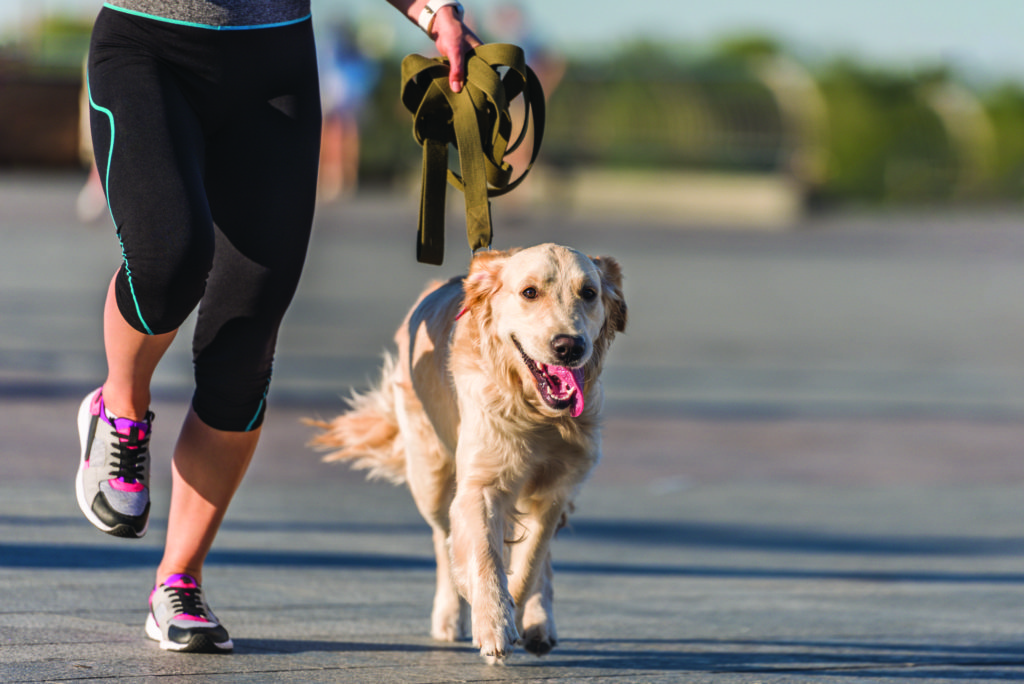
/ Published in Unleash Jacksonville The FREEDOM issue, written by Kate Godfrey, owner Comprehensive Canine Training
There are many reasons why people are bringing their dogs to more “human” events—it can be really fun to have your dog with you, for one! However, it’s important to learn how to read your dog’s subtle signals so that you aren’t unknowingly putting them in a situation that stresses them out.
Not all people do well in crowded places with lots of activity and noise, and the same goes for our dogs. Maybe you have a dog that wouldn’t be comfortable at a concert, festival, or sporting event, but may enjoy a less busy venue like a coffee shop patio, low-key restaurant patio, or park.
If your dog is sensitive to sounds and noise, consider that when planning an outing. Some dogs are sensitive to motion—think children playing, bikes, skateboards, or running humans. Don’t put your dog into situations in which they can’t cope. You don’t want to go full-hog and expose this type of dog to such things (this is called “flooding” and is not a sound training method). Take the time to figure out what outings your dog might enjoy, and respect them.
How do you know if your dog is comfortable?
The dog’s body language will give you all sorts of clues as to their comfort level—the more you get to know your dog, the better you’ll be at picking up the subtle and not-so-subtle messages he sends you.
Signs of canine fear, anxiety, and stress include but are not limited to: Lip licking, tail tucking, turning their head away from stressful stimuli, yawning, lifting a front paw, trembling, wet dog shaking when the dog is not wet or dirty, scratching, sniffing around, excessive salivation/drooling, nose dripping, hackles up, half-moon/whale eye (google that!), refusal to take treats or play with a toy they otherwise love, actively trying to leave the situation, hiding under a table or behind you, and paw sweating. Paw sweating is real. If you take your dog somewhere and see that they’re leaving paw prints on the floor, do them a favor and get them to a space where they’re more comfortable. The behaviors listed above can be thought of as “whispers” in which a dog is quietly telling you—and other dogs—that they’re in distress.
More obvious signs of fear, anxiety, and stress are: Growling, baring teeth, snarling, snapping, and actually biting. A dog doing anything on this list is no longer whispering, it’s shouting, please, please, I need my space—I am warning you! Of note, it’s a bad idea to punish a dog for growling—growling is a warning that should be heeded. Growling is what a dog will resort to when the subtle signs of distress have been ignored or disregarded. If you punish a growl, you’ll create a dog that no longer gives a warning. Instead, interrupt what is happening and get the dog to a place it’s more comfortable. If you need more help, consult with a trainer that practices modern, science-based training methods that do not endorse the use of force, fear, pain, or dominance theory.
A wagging tail isn’t always indicative of a happy dog. Take a look at what the dog’s body, ears, eyes, and mouth are doing. A loose and relaxed body along with the ears in their natural position and an open mouth are good indicators of a relaxed dog. A tight body, closed mouth, ears back, hackles up, and laser-focused stare can be signs that things are not going so well. Redirect the dog’s attention and get them back to a state of comfort, this may require leaving the situation, depending on the dog.
This applies not only to dog outings but to training as well. There’s no sense forcing a dog to try to train or do an activity if it’s frightened or above threshold. No good learning can take place under these circumstances. Now, there is a difference between a dog that is cautious and a dog that is afraid. A cautious dog will likely do some investigating and may overcome its initial aversion, while a dog that is afraid shouldn’t be forced to “suck it up” with the flooding technique mentioned before. Forcing a dog to endure something it’s afraid of is equivalent to forcing some who’s terrified of snakes to hold one.
Manage how people interact with your dog.
I always tell clients, This is your dog, you get to dictate how and IF people interact with your dog. There’s nothing wrong with a polite no thank you, or, we’re in training, please give us space, if someone asks to pet your dog or if they want their dog to say “hello” to your dog. Their dog may be friendly, but if you or your dog are uncomfortable it can be risky. Emotions travel down the leash—if you’re tense and not breathing, you’d better believe that canine at the other end of the leash knows about it.
When out and about with your dog, please remember that you are in charge of keeping them comfortable and safe, and that may differ from what you want them to do. If if you notice signs of anxiety or if someone can’t follow the rules of interacting with your dog, there’s absolutely nothing wrong with exiting the situation. Your dog will let you know if they want to engage and if they don’t—but you need to pay attention and respect their body language and warning signals. If you do, outings with your dogs will be fun for both of you! •
Kate Godfrey, ABCDT, is the owner of Comprehensive Canine Training, LLC, and a major advocate for using science-backed, force-free methods.
www.comprehensivecaninetraining.com
(904) 236-3780
 For many dogs, summertime can be a terrifying time of year (mine are raising their paws over here). Jarring sounds from thunderstorms and fireworks that sometimes come out of the blue are no picnic for pups! It’s natural for them to be afraid of loud noises, as the sounds trigger their nervous system, causing anxiety and fear. Visible signs of distress may include heavy panting, pacing or shaking, yawning, drooling and licking, hiding, and even really funky odor—AKA fear funk.
For many dogs, summertime can be a terrifying time of year (mine are raising their paws over here). Jarring sounds from thunderstorms and fireworks that sometimes come out of the blue are no picnic for pups! It’s natural for them to be afraid of loud noises, as the sounds trigger their nervous system, causing anxiety and fear. Visible signs of distress may include heavy panting, pacing or shaking, yawning, drooling and licking, hiding, and even really funky odor—AKA fear funk. Valerian is an herb native to Asia and Europe whose root has been used in traditional medicine for over 2,000 years! Often referred to as “Nature’s Valium,” this fast-acting herb signals the brain to release the calming chemical, GABA.
Valerian is an herb native to Asia and Europe whose root has been used in traditional medicine for over 2,000 years! Often referred to as “Nature’s Valium,” this fast-acting herb signals the brain to release the calming chemical, GABA.





